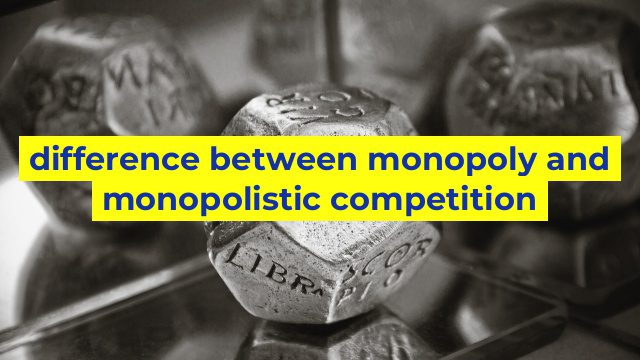Difference between Monopoly and Monopolistic Competition
Monopoly and monopolistic competition are both terms that describe a specific type of market structure. In simple terms, monopoly refers to a market where there is only one seller of a particular good or service, while monopolistic competition refers to a market with many sellers but with differentiated products.
Market Structure Differences
The main differences between monopoly and monopolistic competition lie in their market structures. Monopoly is a market structure where there is only one seller or firm that can produce and sell a particular good or service. This means that consumers have no alternatives, and the firm has complete control over pricing and output decisions. In contrast, monopolistic competition is a market structure that has many sellers of similar but differentiated goods or services. This allows for consumer choice and can lead to greater competition between firms in terms of pricing and product development.
Profit Differences
Another difference between monopoly and monopolistic competition is the potential for profits. Monopolies can enjoy significant profits due to their control over pricing and output decisions. In contrast, firms in monopolistic competition tend to have lower profits because they are competing with other firms in terms of product differentiation and pricing. In order to increase profits, firms in monopolistic competition must focus on better products or services compared to their competitors.
Market Entry Barriers
Market entry barriers refer to the challenges and costs associated with entering a particular market. Monopolies typically have high barriers to entry, which means that it is difficult for new firms to enter the market and compete with the monopoly. This is because the monopoly already controls the market, and any new entrant will have to establish themselves from scratch. In contrast, monopolistic competition has low barriers to entry, which means that new firms can enter and compete more easily.
Conclusion
In summary, monopoly and monopolistic competition are two different market structures that affect firms and consumers in different ways. While monopolies have no competition, they also have higher market entry barriers and the potential for higher profits. Monopolistic competition, on the other hand, has greater competition among firms, lower profits, and lower barriers to entry. Understanding these differences is important for business owners, economists, and policymakers in developing strategies and policies that can promote competition and protect consumers.
Table difference between monopoly and monopolistic competition
| Aspect | Monopoly | Monopolistic Competition |
|---|---|---|
| Structure | Single seller | Many sellers |
| Price | Higher prices set by the monopolist | Somewhat higher prices than perfect competition, but not as high as monopoly |
| Entry barriers | High | Low |
| Product differentiation | No close substitutes | Close substitutes available, but products may still be differentiated |
| Profit maximization | Maximizing profit by producing where marginal revenue equals marginal cost | Maximizing profit by producing where marginal revenue equals marginal cost and where perceived demand equals marginal cost |

